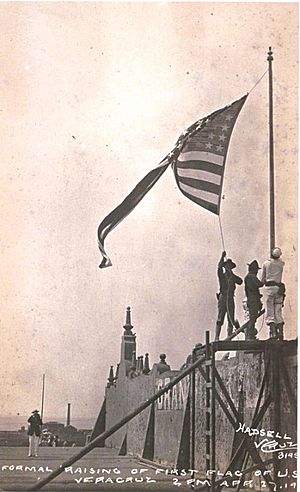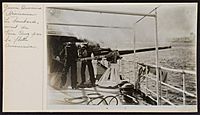United States occupation of Veracruz facts for kids
Quick facts for kids United States occupation of Veracruz |
|||||||
|---|---|---|---|---|---|---|---|
| Part of the Mexican Revolution | |||||||
 John H. Quick raises the American flag over Veracruz |
|||||||
|
|||||||
| Belligerents | |||||||
Support: |
Support: |
||||||
| Commanders and leaders | |||||||
Juan Esteban Morales |
|||||||
| Strength | |||||||
| 7 battleships 2 light cruisers 1 auxiliary cruiser |
|||||||
| Casualties and losses | |||||||
| 21 killed 74 wounded 1 drowned |
302–322 killed 195–250 wounded |
||||||
The United States occupation of Veracruz happened from April 21 to November 23, 1914. It started with the Battle of Veracruz and lasted for seven months. This event was a response to the Tampico Affair on April 9, 1914. It took place when relations between Mexico and the United States were difficult. It was also connected to the ongoing Mexican Revolution.
Contents
Why the US Occupied Veracruz
Troubled Relations Between the US and Mexico
Relations between the United States and Mexico were tense for many years. This tension began after the Mexican–American War (1846-1848). In that war, Mexico lost a large part of its land to the U.S. This created bad feelings between the two countries.
Things got better for a while during Abraham Lincoln's time as U.S. President. He helped Mexico during its war against French occupation. Later, Mexican leader Porfirio Díaz (1876-1911) encouraged U.S. businesses to invest in Mexico. This helped Mexico's economy.
However, problems returned in 1911 when Díaz resigned. The U.S. Ambassador to Mexico, Henry Lane Wilson, worked to remove Díaz's replacement, Francisco I. Madero. Wilson wanted General Victoriano Huerta to be in charge instead. This led to a violent event in February 1913 called La Decena Tragica, where Huerta took power.
President Wilson's Actions
After Woodrow Wilson became U.S. President in March 1913, he did not support Victoriano Huerta's government. Wilson also asked other powerful European countries to do the same. The situation got worse when Wilson stopped weapons from being sent to Mexico in August 1913.
In October 1913, rebellions started in Mexico. Pancho Villa and Emiliano Zapata led these revolts. They began after Huerta won an election that many believed was unfair. The U.S. then sent weapons to Villa to help him fight Huerta.
The Tampico Affair and the Ypiranga Incident
The main reason for the occupation was the Tampico Affair. Nine American sailors were arrested by Mexican officials in Tampico, Tamaulipas. They had entered an area that was off-limits. The sailors were released, but the U.S. naval commander, Henry T. Mayo, demanded an apology and a special 21-gun salute. Mexico apologized but did not give the salute.
Because of this, U.S. President Woodrow Wilson ordered the U.S. Navy to get ready to take over the port of Veracruz. While waiting for permission from the U.S. Congress, Wilson learned about a ship carrying weapons for Victoriano Huerta. This German ship, the SS Ypiranga, was due to arrive in Veracruz on April 21.
Wilson immediately ordered his forces to seize the port's customs office. They were to stop the weapons from reaching Huerta. It turned out that an American businessman and a Russian arms dealer had bought the weapons. Newspapers at the time incorrectly reported that the German government was involved.
Some of these weapons came from the Remington Arms company in the U.S. They were shipped through Odessa and Hamburg to get around the American arms ban. Even though the weapons were stopped at Veracruz, they were later unloaded at another port controlled by Huerta.
The US Landing in Veracruz
On the morning of April 21, 1914, U.S. Navy warships prepared to take over the Veracruz waterfront. Rear Admiral Frank Friday Fletcher led these forces. His orders were to "Seize custom house. Do not permit war supplies to be delivered to Huerta government or any other party."
At 11:12 AM, the first U.S. Marines landed from the ship USS Prairie. Other boats carried 502 Marines and 285 armed Navy sailors, called "Bluejackets." These sailors came from the battleships USS Florida and USS Utah.
The American consul, William W. Canada, told General Gustavo Maass that the Americans were taking over the port. He asked Maass to help keep order. However, Mexico City told Maass not to surrender the port.
Maass ordered his soldiers to give rifles to the people and prisoners in "La Galera" military prison. They were all to go to the dock area. Maass also ordered another group of soldiers to take positions on Pier Number Four. He then sent a message to Mexico City about the invasion. The Minister of War, General Aurelio Blanquet, told Maass not to fight. He was told to retreat inland to Tejería.
The American landing party reached Pier 4 at 11:20 AM. Many Mexican and American citizens watched. The American forces, led by Marine Lt. Col. Wendell C. Neville, moved to their targets without resistance. By 11:45 AM, they had taken the rail terminal and cable station.
Commodore Manuel Azueta encouraged cadets from the Veracruz Naval Academy to defend the port.
The Battle of Veracruz
Three Navy rifle companies were ordered to capture the customs house, post, and telegraph offices. Marines aimed for the railroad terminal, cable office, and power plant.
Weapons were given to the local people. However, many were not trained to use the rifles and struggled to find the right ammunition. This lack of organization and supplies made it hard for the people to defend their city. Prisoners from "La Galera" military prison were also released to help defend.
Most of the regular Mexican troops retreated with General Maass. But the released prisoners and some civilians fought the Americans. They fired on the Americans at 11:57 AM. A Navy signalman was the first American casualty. By the end of the day, 4 Americans were dead and 20 wounded.
At 1:30 PM, the Ypiranga ship was stopped. It was prevented from unloading its cargo of weapons and ammunition.
On the night of April 21, Admiral Fletcher decided to take control of the entire city, not just the waterfront. The next day, at 8:00 AM, he gave orders to do so.

More American ships arrived and unloaded troops. By 3:00 AM, more than 3,000 American men were ashore.
On April 22, at 7:45 AM, the American advance began. The Marines quickly learned how to fight in the streets. Sailors were less used to this type of fighting. One group of Navy men marched in a straight line towards the Naval Academy. This made them easy targets for those inside. The attack was first pushed back. Then, three warships in the harbor used their big guns to fire on the academy. This stopped all resistance.
The city was secured by 11:00 AM. By evening, over 6,000 American troops were ashore.
A small group of naval aircraft arrived on April 24. They flew reconnaissance missions around Veracruz. This was the first time U.S. naval aircraft were used in a real operation. It was also the first time U.S. aviators were shot at from the ground.
On April 26, Admiral Fletcher declared martial law. He began to hand over control of the occupation to the American army, led by General Frederick Funston. In total, 19 American sailors and Marines were killed.
More Marines arrived on May 1. They stayed in the city until the U.S. left on November 23. The U.S. withdrawal happened after Argentina, Brazil, and Chile (known as the ABC powers) helped settle the issues between the two nations. This happened at the Niagara Falls peace conference.
What Happened After the Occupation
U.S. Army General Frederick Funston was put in charge of running the port. A young Captain Douglas MacArthur was on his staff as an intelligence officer.
Mexican President Huerta could not fully respond to the U.S. invasion. He was busy dealing with the Mexican Revolution. Many revolts were happening across Mexico. The most important ones were led by Villa and Zapata. Venustiano Carranza also rebelled against Huerta. These rebellions led to the Battle of Zacatecas in June 1914. Huerta's army lost many soldiers, which led to his resignation.
The occupation of Veracruz brought the U.S. and Mexico very close to war. It made relations between the two countries worse for many years. Argentina, Brazil, and Chile held the Niagara Falls peace conference in Niagara Falls, Ontario, Canada, on May 20. They wanted to prevent a full war and stop the U.S. from becoming too powerful in the region.
A plan was made for U.S. troops to leave Veracruz. This would happen after General Huerta left power and Mexico agreed not to ask for money for its losses. Huerta soon resigned and gave his government to Carranza. Carranza was still unhappy about U.S. troops in Veracruz and rejected part of the agreement.
In November 1914, after some political changes in Mexico, Carranza left Mexico City. He went to the state of Veracruz and made the city of Cordoba his capital. He then agreed to the rest of the peace plan. U.S. troops officially left Veracruz on November 23. After this, relations between the U.S. and Carranza's government improved greatly.
Medals and Heroes
After the fighting, U.S. Secretary of the Navy Josephus Daniels ordered that 56 Medals of Honor be given to those who fought. This was the most medals given for any single action before or since. Some people criticized this, saying too many medals were given out. Major Smedley Butler, who received one of these medals, later tried to return it. He felt he had not done anything heroic enough to deserve it.
The controversy over these medals led to stricter rules for awarding the Medal of Honor. It also led to the creation of lower-ranking medals to recognize other achievements.
In Mexico, Naval Lt. Azueta and Cadet Midshipman Virgilio Uribe died during the fighting. They are now honored as heroes. Their names are called out in a special "roll call of honor" by all parts of the Mexican Armed Forces. This happens during all military events. They are honored alongside the six Niños Héroes who died defending their country in 1847. Because of the brave defense by the Naval School cadets, it is now called the Heroic Naval Military School of Mexico.
Political Impact of the Occupation
The U.S. invasion of Veracruz caused anti-U.S. protests in several countries. These included Mexico, Argentina, Chile, Costa Rica, Ecuador, Guatemala, and Uruguay. U.S. citizens were forced to leave Mexico. Some had to stay in refugee camps in the U.S. The British government was also annoyed because they had agreed with Wilson that the U.S. would not invade Mexico without warning.
The invasion also played a big part in keeping Mexico neutral in World War I. Mexico refused to join the U.S. in the war in Europe. It allowed German companies to continue operating in Mexico City. The tension between the U.S. and Mexico was so high that Germany offered to help Mexico get back land lost to the U.S. in the Mexican-American War. In return, Mexico would help Germany in World War I. The Mexican government refused this offer.
U.S. President Woodrow Wilson thought about invading Veracruz and Tampico again in 1917–1918. He wanted to control the Tehuantepec Isthmus and the Tampico oil fields. But the new Mexican President Venustiano Carranza ordered that the oil fields be destroyed if the U.S. Marines tried to land there. As one expert said, "Carranza may not have fulfilled the social goals of the revolution, but he kept the gringos out of Mexico City."
Images for kids
-
"Defensores de Veracruz en 1914" Memorial in Mexico City. This monument celebrates the Mexican defenders of Veracruz.
See also
 In Spanish: Ocupación estadounidense de Veracruz de 1914 para niños
In Spanish: Ocupación estadounidense de Veracruz de 1914 para niños







